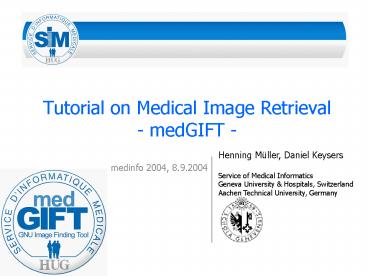Tutorial on Medical Image Retrieval medGIFT - PowerPoint PPT Presentation
1 / 16
Title:
Tutorial on Medical Image Retrieval medGIFT
Description:
Geneva University & Hospitals, Switzerland. Aachen Technical ... Gift-add-collection - add all files in a directory/sub dir. Gift - start server at port number ... – PowerPoint PPT presentation
Number of Views:61
Avg rating:3.0/5.0
Title: Tutorial on Medical Image Retrieval medGIFT
1
Tutorial on Medical Image Retrieval- medGIFT -
- medinfo 2004, 8.9.2004
Henning Müller, Daniel Keysers Service of
Medical Informatics Geneva University
Hospitals, Switzerland Aachen Technical
University, Germany
2
Overview
- The Viper project
- The GNU Image Finding Tool
- Download, use and support
- Interfaces, MRML
- Casimage
- The medGIFT project
- Interface
- Adaptations
- Current work
- Noise reduction, specialization
3
Viper
- Visual Information Processing for Enhanced
Retrieval - Demo http//viper.unige.ch/
- Uses techniques well known from text retrieval
- Large feature space with a Zipf distribution of
features, similar to words in text - Frequency-based feature weights
- Inverted files
- Relevance feedback schemes
- Now work on video retrieval, classification and
semantic annotation
4
Visual features used
- Global color histogram (HSV, 18, 3, 3, 4 gray
levels) - Color blocks at different scales and locations
- Histogram of Gabor filter responses
- 4 directions, 3 scales, quantized in 10 strengths
- Gabor blocks at different scales and locations
- 85,000 possible features, 1,000-3,000 features
per image, distribution similar to words in
text collections
5
GIFT GNU Image Finding Tool
- http//www.gnu.org/software/gift/
- Outcome of the Viper project
- Open framework for image retrieval
- Continued at several Universities
- Germany, Australia, Switzerland,
- KMRML as a plugin into Konqueror
- Plugin for Gimp
- User interfaces in Java, PHP, CGI/perl, JSP
- Infrastructure at GNU
- Mailing list for help and error reports
- ftp server, web pages
6
The GIFT framework
7
MRML Multimedia Retrieval Markup Language
- Open communication interface
- Socket-based communication
- Images are referred to by URLs
- XML-based language, Human-readable
ltmrml session-id"1" transaction-id"44"gt ltquery-s
tep session-id"1" resultsize"30"
algorithm-id"algorithm-default"gt
ltuser-relevance-listgt ltuser-relevance-element
image-location"http//viper/1.jpg"
user-relevance"1"/gt ltuser-relevance-element
image-location"http//viper/2.jpg"
user-relevance"-1"/gt lt/user-relevance-listgt lt/q
uery-stepgt lt/mrmlgt
8
Functionalities of GIFT
- Works under Linux, ports underway for MacOS X and
Windows via Cygwin - GPL license, open source
- Normally a simple configmakemake install
- Depending on the version, sometimes perl modules
miss - Gift-add-collection - add all files in a
directory/sub dir - Gift - start server at port number
- Gift-create-inverted-file creates the index
- FeatureExtraction - can be changed depending on
DB
9
Casimage a radiological case database
- Case database for teaching
- http//www.casimage.com/, interface developed
with the proprietary 4D software - gt60,000 images, 9000 images externally
accessible, 500 added per week - Case descriptions (textual) available in XML
- Very varying quality
- Mix of French and English
- Interface is compatible to the MIRC (Medical
Image Resource Center) standard of the RSNA
10
medGIFT
- http//www.sim.hcuge.ch/medgift/ (open source)
- Project for content-based search in medical image
databases - Goals of the project
- Better management of visual medical data
(retrieval) - Visual Knowledge Management
- Textual and visual data
- Diagnostic aid
- Specialized retrieval (lung CTs, dermatological
images) - Access to PACS data
- In the short term
- Research
- Teaching
11
The user interface
Query image
Diagnosis
Link to casimage
Similarity score
12
Main projects within medGIFT
- Evaluation of image retrieval algorithms
- Reference data sets, imageCLEF
- Specialized application domains
- Lung CT retrieval
- Dermatology
- Pathology
- Development of a feature framework
- Feature selection
- Combination of textual and visual features
- Which combination for which task?
- Systematic testing with the imageCLEF data
13
Lung CT segmentation
14
Background removal for retrieval
- Many images contain a large background part that
is basically noise - Or even worse if colored or textured
- Teaching file contains frame around images
15
Retrieval with/without background
16
Conclusions
- medGIFT/GIFT is an open source framework, free of
charge for medical image retrieval - Makes it easy to get a project started
- Has an open infrastructure and a framework of
interchangeable components - Exchange of components between research groups is
one of the goals































